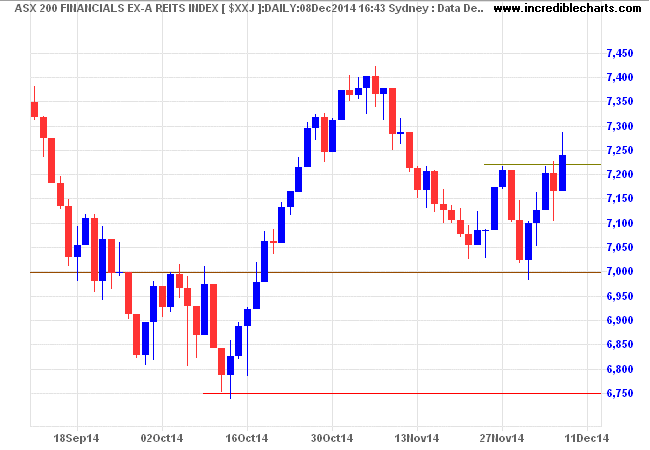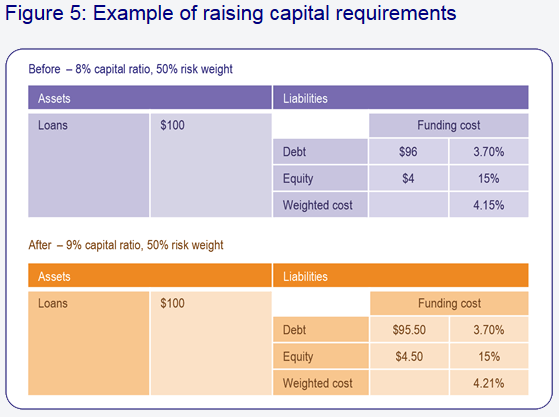Australian banks rally on Murray Report
By Colin Twiggs
December 8th, 2014 1:00 a.m. EDT (5:00 p.m. AEST)
Advice herein is provided for the general information of readers and does not have regard to any particular person's investment objectives, financial situation or needs. Accordingly, no reader should act on the basis of any information contained herein without first having consulted a suitably qualified financial advisor.
The ASX 200 Financial sector (ex-REITs) responded well to release of David Murray's report into the financial services industry. As the largest constituent of the ASX 200 index, comprising more than one-third of market capitalization, sector performance is critical in determining future direction of the broader index. Breach of resistance at 7220 suggests that the correction is over. Follow-through above 7400 would confirm a fresh primary advance.

David Murray's Financial System Inquiry
The Final Report of the Financial System Inquiry, led by ex-Commonwealth Bank CEO David Murray, calls on Australian banks to become "unquestionably strong" to prevent another financial crisis. The FSI calls for increased bank capital in the form of common equity, with capital ratios increasing from an average of 9.1% to the 12.2% threshold for the top quartile of international banks. The FSI also proposes that banks increase their average risk-weighting for home mortgages to 25-30% compared to current weightings as low as 15%.
Chris Joye from the AFR estimates that the first proposal would require about $21 billion in new capital, while increased risk-weighting would require an additional $15 billion. There may be some overlap between the two, but the combined requirement is likely to be more that $30 billion.
Impact on consumers is likely to be negligible. The FSI projects that a 1% increase in bank capital ratios would increase the weighted cost of capital by 6 basis points (0.06%) because of the higher cost of equity capital.

But this does not take account of lower risk premiums required, for debt and equity, when capital is increased. A reduction of debt funding costs to 3.65% and equity to 14.75% would offset the increase in equity capital; so the actual cost increase may be considerably smaller.
A resilient banking system would not only avoid significant losses of GDP (as high as 158 percent) in the event of a financial crisis, but would save up to 900,000 jobs according to the FSI. In addition, reduced risk of a government bailout would minimize the threat to government debt levels and Australia's AAA credit rating. Banks would also benefit through improved profitability and stronger growth prospects.
My concerns with FSI are mainly long-term. Raising capital ratios to the top quartile of international banks would certainly improve the resilience of Australian banks, but this is a moving target. We can expect average capital held by international banks to increase as other countries conduct their own reviews into the adequacy of bank funding. Also, leverage ratios (ignoring risk-weighting) remain low and should be progressively lifted towards a long-term goal of 6 to 8 percent. Reliance solely on risk-weighted capital ratios can encourage industry-wide concentration in low-risk-weighted assets which in turn will elevate risk. Lastly, bail-in bonds are dangerous — any attempt at conversion would destroy creditor confidence in the banking system with far-reaching repercussions — and should be discouraged.
I believe that stronger capital ratios are a win for both Australian taxpayers and bank shareholders. Implementation of the FSI recommendations would be a major advance towards building a resilient and sustainable banking sector.
I believe that banking institutions are more dangerous to our liberties than standing armies.
~ Thomas Jefferson
Disclaimer
Research & Investment Pty Ltd is a Corporate Authorized Representative (AR Number 384 397) of Andika Pty Ltd which holds an Australian Financial Services Licence (AFSL 297069).
The information on this web site and in the newsletters is general in nature and does not consider your personal circumstances. Please contact your professional financial adviser for advice tailored to your needs.
Research & Investment Pty Ltd ("R&I") has made every effort to ensure the reliability of the views and recommendations expressed in the reports published on its websites and newsletters. Our research is based upon information known to us or which was obtained from sources which we believe to be reliable and accurate.
No guarantee as to the capital value of investments, nor future returns are made by R&I. Neither R&I nor its employees make any representation, warranty or guarantee that the information provided is complete, accurate, current or reliable.
You are under no obligation to use these services and should always compare financial services/products to find one which best meets your personal objectives, financial situation or needs.
To the extent permitted by law, R&I and its employees, agents and authorised representatives exclude all liability for any loss or damage (including indirect, special or consequential loss or damage) arising from the use of, or reliance on, any information. If the law prohibits the exclusion of such liability, such liability shall be limited, to the extent permitted by law, to the resupply of the said information or the cost of the said resupply.
Important Warning About Simulated Results
Research & Investment (R&I) specialise in developing, testing and researching investment strategies and systems. Within the R&I web site and newsletters, you will find information about investment strategies and their performance. It is important that you understand that results from R&I research are simulated and not actual results.
No representation is made that any investor will or is likely to achieve profits or losses similar to those shown.
Simulated performance results are generally prepared with the benefit of hindsight and do not involve financial risk. No modeling can completely account for the impact of financial risk in actual investment. Account size, brokerage and slippage may also diverge from simulated results. Numerous other factors related to the markets in general or to the implementation of any specific investment system cannot be fully accounted for in the preparation of simulated performance results and may adversely affect actual investment results.
To the extent permitted by law, R&I and its employees, agents and authorised representatives exclude all liability for any loss or damage (including indirect, special or consequential loss or damage) arising from the use of, or reliance on, any information offered by R&I whether or not caused by any negligent act or omission.

Author: Colin Twiggs is a former investment banker with almost 40 years of experience in financial markets. He co-founded Incredible Charts and writes the popular Trading Diary and Patient Investor newsletters.
Using a top-down approach, Colin identifies key macro trends in the global economy before evaluating selected opportunities using a combination of fundamental and technical analysis.
Focusing on interest rates and financial market liquidity as primary drivers of the economic cycle, he warned of the 2008/2009 and 2020 bear markets well ahead of actual events.
He founded PVT Capital (AFSL No. 546090) in May 2023, which offers investment strategy and advice to wholesale clients.
